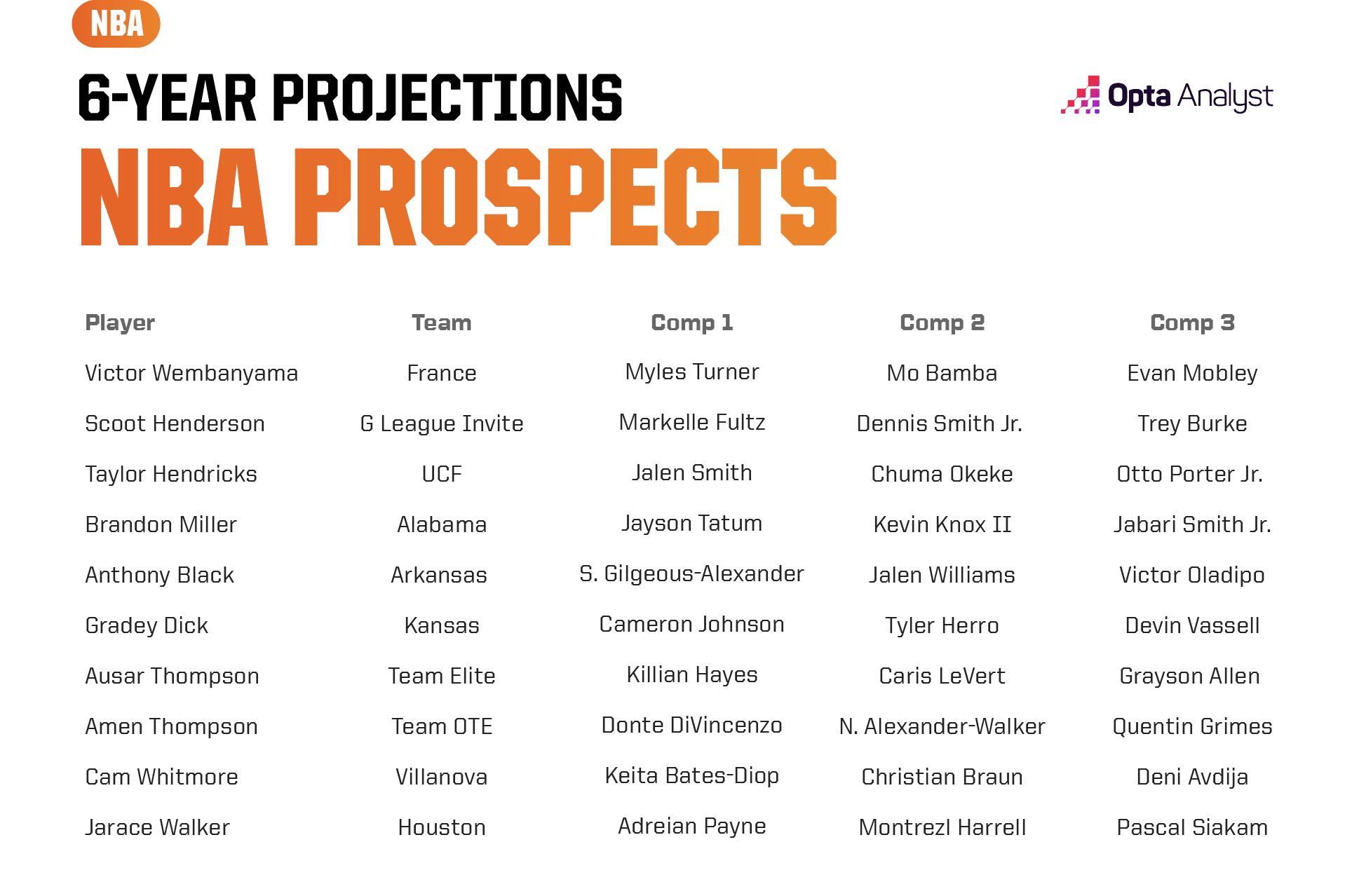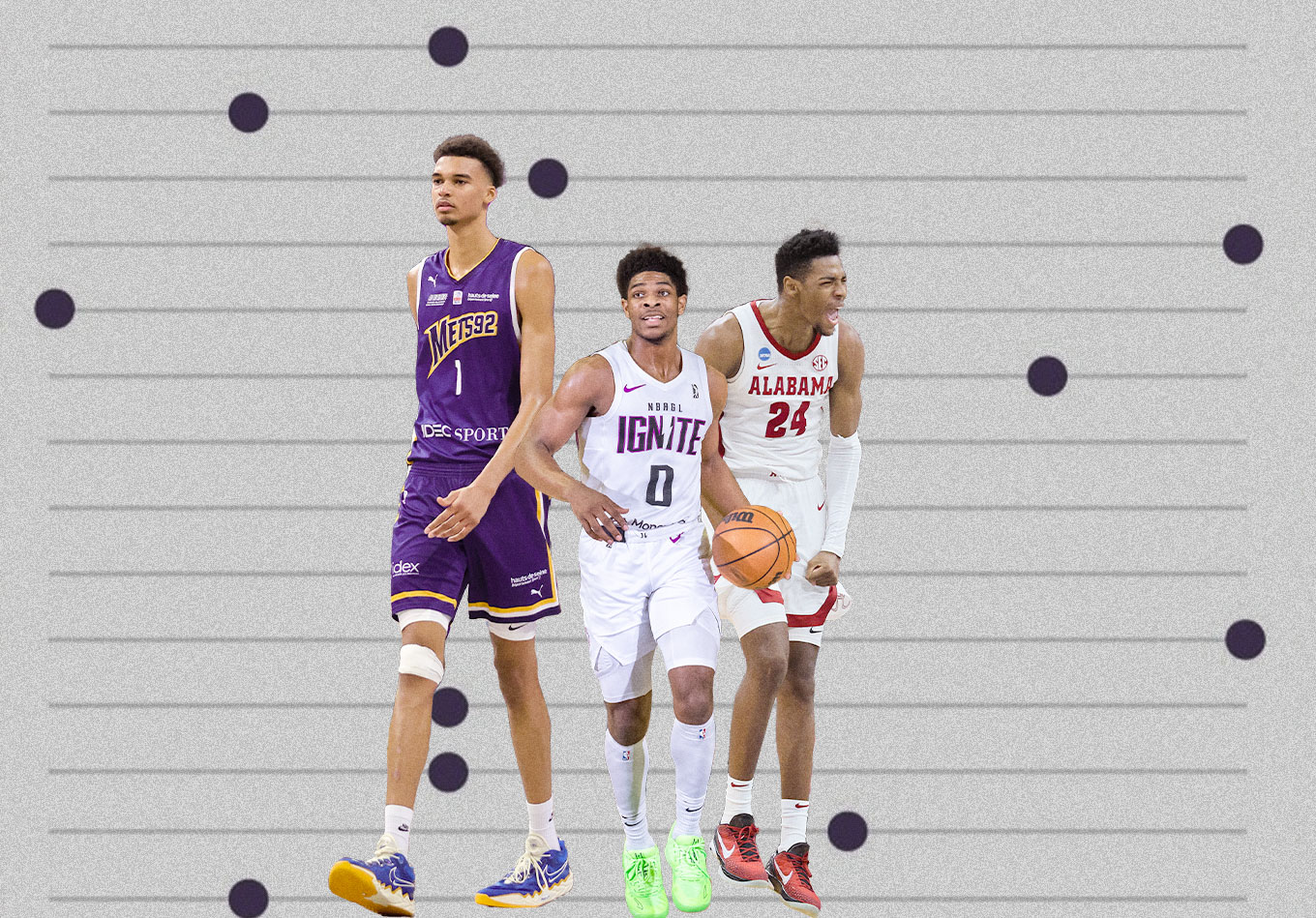He’s been called the greatest prospect since LeBron James, the next Kevin Durant and Hakeem Olajuwon or Kareem Abdul-Jabbar with handles and an outside shot.
But how do French phenom Victor Wembanyama’s comparisons change when they’re generated from volume- and rate-based stats and advanced data instead of opinions on who he reminds people of based on his body type and playing style?
Brandon Miller, No. 2 on most big boards, has been compared to Paul Pierce, Paul George and/or Danny Granger, depending on who you ask. Would that still be the case if we used various levels and types of player data to determine comps for the Alabama prospect?
We’re going to find out by using our NBA Draft model, which is derived from an array of statistical inputs, consensus draft rankings and biographical/anthropometric information to determine where a prospect stands relative to his peers in the class.
The model also incorporates data from AutoStats, which uses AI-enhanced body recognition technology to identify player position and movement across the entirety of the court. And the model’s sliders (see below) can be used to emphasize certain physical and statistical traits if you so choose.
For our purposes of finding overall rankings and player comparisons, we’re going with sliders that weigh everything about the same.
With this model, we also have the ability to set the DRIP, which is a projection of a player’s contribution to team plus-minus per 100 possessions, anywhere between Year 1 to Year 6, depending on what point in the development process we want to forecast.
Our comps list is ranked in order of total DRIP accumulated through the first six years of the player’s career with Wemby first ahead of Scoot Henderson, Taylor Hendricks from UCF, Miller, Anthony Black from Arkansas, Gradey Dick, Overtime Elite’s Ausar and Amen Thompson, Cam Whitmore out of Villanova and Houston product Jarace Walker.
It’s also important to note that while the model’s NBA comparisons are meant to be at the time those players were entering the draft, it does open the imagination to potential projections.
Here’s a look at our model’s 10 best prospects for the 2023 NBA Draft, along with their top three NBA player comps:

In case you’re wondering, Cason Wallace of Kentucky, Michigan product Kobe Bufkin, Wembanyama’s teammate Bilal Coulibaly of Metropolitans 92, Arkansas product Nick Smith Jr., Trayce Jackson-Davis and Jalen Hood-Schiifino from Indiana, 6-foot-9 big man Drew Peterson, New Zealand Breakers product Rayan Rupert, Pepperdine’s Maxwell Lewis and James Nnaji from Barcelona (ACB) are 11th through 20th in the rankings.
Now we know what you’re thinking; Myles Turner, Mo Bamba and Evan Mobley don’t exactly scream superstar prospect. But are those comps more realistic for Wembanyama than LeBron, KD or Olajuwon? Probably. Wemby is something of a unicorn, but Turner makes some sense because of his height, shooting potential and shot-blocking ability at the time he was entering the NBA.
Turner shot 27.4% from 3-point range in his only season at Texas, but he shot 83.9% from the line – often an indicator of perimeter-shooting potential. And the Indiana Pacers big man has made 1.5 3s per game in each of the last three seasons. If we dig further down the comp list, we find other two-way standouts like Jaren Jackson Jr. (fourth-closest comp) and Karl-Anthony Towns (sixth).
Wemby’s potential two-way greatness is evident when considering he ranks first in the draft class in offensive DRIP ahead of Year 6 and owns the top three ranks – Years 1, 2 and 4 – in single-season defensive DRIP over this span.
Similarly, Henderson’s top comp of Markelle Fultz might not inspire confidence at first glance. But remember, before inexplicably struggling with his shot, Fultz was thought of as a capable shooter heading into the league after hitting 41.3% from deep at Washington. If the G League Ignite prospect can max out as Fultz with a dangerous perimeter game, it would be pretty darn good.
Scoot has three of the top seven single-season offensive DRIP (O-DRIP) numbers – Years 3, 4 and 5 – in the entire class out of the six years we’ve forecasted.
Jayson Tatum jumps off the page as the No. 1 comp for Miller, according to our model. The Boston Celtics star had an array of offensive moves, an advanced skill set and a solid physical profile coming out of Duke, though there were questions about what his role would be at the next level. The same can certainly be said about Miller.
There’s a lot to like about the three comps for Black. Shai Gilgeous-Alexander averaged 10.8 points in his rookie season with the Los Angeles Clippers, but he’s blossomed into an All-Star for the Oklahoma City Thunder. Jalen Williams averaged 14.1 points and finished second in the NBA Rookie of the Year voting this past season, while Victor Oladipo was an instant contributor at 13.8 points per game for the Orlando Magic in 2013-14.
Dick, who played at Kansas, has two of the top three O-DRIP numbers – Years 3 and 4 – in the draft class. Miller’s Year 4 O-DRIP was the second highest over this span.
If a team likes a player, they’re often nervous about the team in front of them stealing that prospect. With the Thompson twins, a club will have two shots at drafting a similar player. That’s because Amen and Ausar Thompson not only look alike, but they also have similar games and share many of the same comps, including Killian Hayes, Caris LeVert, Grayson Allen, Tre Mann, Quentin Grimes and Donte DiVincenzo.
Amen Thompson, however, ranks up among the best in the draft class in single-year O-DRIP. His Year 3 O-DRIP is the fourth highest of any of the six years we’re looking at, while his brother Ausar’s Year 3 O-DRIP ranked ninth over this span.
Projected Progression
So we’ve given you the total combined DRIP rankings for 2023 NBA Draft prospects through their first six years. Now let’s take a look at how their career progression projects out.
Below is an interactive graphic in which you can view the total (offensive plus defensive) DRIP rankings heading into the draft (Year 1), Years 2-6 and then the combined DRIP totaling Years 1-6 (Combined DRIP).
Keep in mind that the standard rookie contract lasts for two years with the option of resigning for a third season and a rookie’s salary is determined by the NBA’s rookie salary scale, which is based on draft position. So, in theory, a player should be heading into the start of his prime by Year 4.
The Year-1 projections point to Wemby needing a little bit of time to develop after the San Antonio Spurs (most likely) take him at No. 1 overall. Miller averaged 18.8 points and 8.2 rebounds in the SEC and will turn 21 in November, while Wembanyama averaged 21.6 points and 10.6 boards in France and won’t even turn 20 until January.
However, by the time we get to Year 2, Wemby is projected to take over as the No. 1 player in this draft class. And by the time we get to Year 6, the 7-foot-2 sensation is far ahead of the rest of the field with Henderson is second.
Henderson and Hendricks, a pair of 19-year-old prospects, are projected to surpass Miller in total contribution to their respective teams’ plus-minus over the first six years of their careers. We’ve mentioned Henderson and his potential earlier, but Hendricks ranks high in a lot of different areas.
He’s also the only player not named Victor Wembanyama to have a single-season defensive DRIP ranking in the top five (fourth) in this draft class. He rates highly in team efficiency when he receives a dribble handoff, how often he switches on ball screens, and various rebound metrics.
While the 6-foot-8, 214-pound forward is being selected at the back end of the first round’s top 10 in most mock drafts, Hendricks’ potential as an all-around contributor should make whichever team lands him very happy.
Data modeling provided by Matt Scott of Stats Perform. Enjoy this? Follow us on Twitter.
